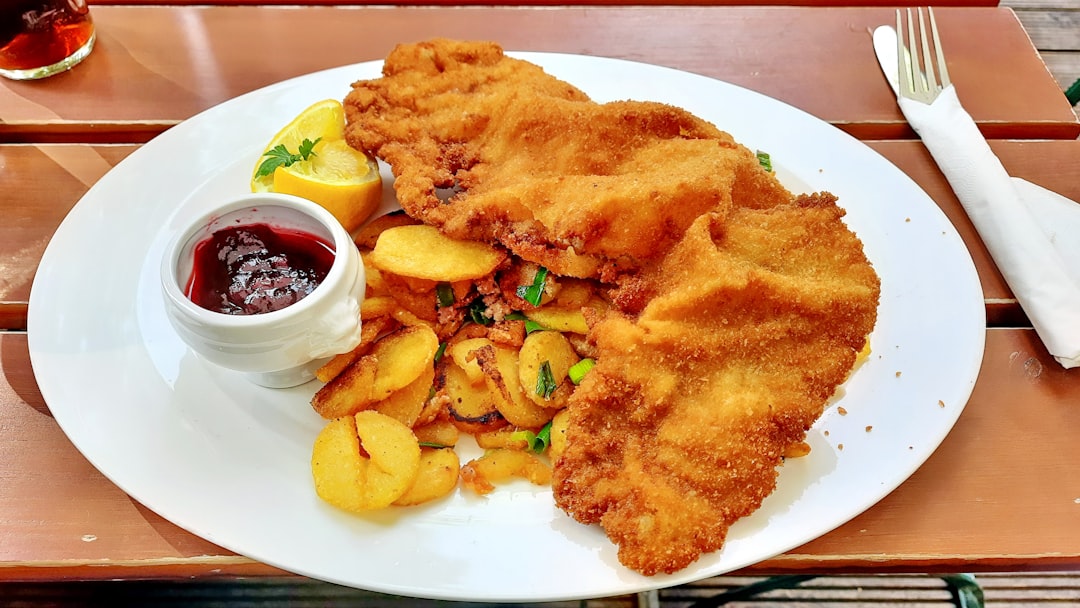Schnitzel
A Schnitzel is essentially a thin cutlet of veal, pork, or chicken pounded flat, breaded and fried until golden-brown and crisp. This simple preparation may sound straightforward, however, there is an art to properly executing a good Schnitzel. The most striking part of the dish lies in its texture; the careful pounding process results in a product with a flavorful crumb-like coating that is crunchy on the outside, yet tender and juicy inside.
The traditional accompaniments to a Schnitzel add another dimension to its flavor. A dollop of tartar sauce, a side of spätzle and an array of pickles make for a complete experience that is both comforting and exciting. And for the adventurous eater, a variety of unique sauces, from mushroom gravy to lingonberry jam, can be tried to give the Schnitzel a new spin.
No matter how you choose to prepare it, the Schnitzel is a timeless classic that can bring people together in ways that no other dish can. Its inviting presence and unassuming yet complex flavors make it an ideal choice for any gathering - whether with friends around the dinner table, or as a rustic picnic dish.
So if you're in the mood for something special, don't hesitate to give the Schnitzel a try. You won't be disappointed.
Schnitzel recipes
Amazing Schnitzel recipes sourced from the web.
The origin of Schnitzel
When it comes to the family of fried dishes, Schnitzel is a venerable and storied member. Its origin can be traced back to late 18th century Austria, where it was a renowned mainstay of Viennese cuisine. Its exact inception is not known, but it owes its birthplace and overall culinary distinction to the ingenuity and experimentation of Austrian cooks.
The Fried breaded veal cutlets that now comprise Schnitzel were created through a masterful coalescence of two distinct ideas. On one side, the Saxons had been a thriving Germanic culture for hundreds of years and their cuisine showcased the tendency to fry food in fat as a cooking method. On the other, Austrian cooks found an affinity for breading, which likely originated from Italian influences. When these two concepts came together, Schnitzel was born – a delectably crispy, succulent delicacy that has since found success far beyond the cultural bounds of its birthplace.
Over the last few centuries, Schnitzel has gained popularity and spread its influence far beyond Austria. This tasty treat can now be found in numerous countries across Europe and around the world, often with fine alterations tailored for local tastes and palettes. From Germany’s Wiener Schnitzel with egg and lemon, to Japan’s Pork Katsu and Chicken Katsu, Schnitzel’s original recipe is undergoing a delicious metamorphosis.
Given its enduring success and far-reaching ubiquity, there’s no doubt Schnitzel will continue to be a popular dish for many more years to come.
Types of Schnitzel
Schnitzel, a beloved classic dish that is beloved all over the world, has many tantalizing variations. Depending on region and preference, there are a variety of options to choose from that are sure to delight the palate.
For those unfamiliar with the concept, schnitzel is a type of thin-cut meat that is typically served with a savory breading. The most common version of the dish is a pork, veal, or chicken steak cooked with a crispy, golden brown crust. From there, different regions have put their own spin on this hearty dish.
The Austrian version of schnitzel is Wiener Schnitzel, which is usually made with a veal cutlet. The cutlet is thin and lightly pounded before being coated in flour, egg, and panko breadcrumbs. It's then fried until it's crisp and golden. This classic variation is often served with potato salad or lemon wedges.
The Italian version of schnitzel is known as Saltimbocca, which is usually made with thinly sliced veal that is then wrapped around a slice of prosciutto and sage. This "jumping in the mouth" dish is also coated in flour, egg, and panko breadcrumbs, then fried until golden. It is typically served with a side of sauteed spinach.
The German version of schnitzel is Jagerschnitzel, which is traditionally made with a pork cutlet. The cutlet is thin and lightly pounded before being pan seared and finished with a mushroom gravy. This hearty meal is usually served with spaetzle, a type of egg noodle, or a side of red cabbage.
Finally, the Japanese version of schnitzel is called Katsu, which is thin-cut pork, beef, or chicken that is then coated in panko and deep-fried. The crunchy, flavorful crust is especially popular among kids. Katsu is usually served with a side of rice, cabbage, and tonkatsu sauce.
No matter which variation you choose, schnitzel is sure to satisfy a hearty appetite. Its versatile nature allows for endless possibilities when creating unique dishes. Whether you prefer a classic version or an exotic twist on this beloved staple, you're sure to enjoy!



